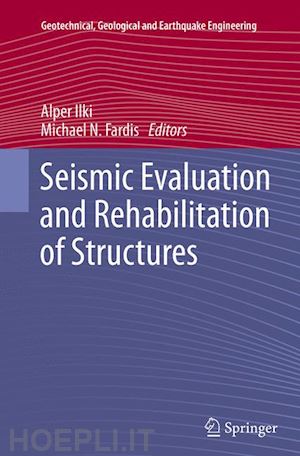
Questo prodotto usufruisce delle SPEDIZIONI GRATIS
selezionando l'opzione Corriere Veloce in fase di ordine.
Pagabile anche con Carta della cultura giovani e del merito, 18App Bonus Cultura e Carta del Docente
In the past, facilities considered to be at the end of their useful life were demolished and replaced with new ones that better met the functional requirements of modern society, including new safety standards. Humankind has recently recognised the threats to the environment and to our limited natural resources due to our relentless determination to destroy the old and build anew. With the awareness of these constraints and the emphasis on sustainability, in future the majority of old structures will be retrofitted to extend their service life as long as feasible. In keeping with this new approach, the EU’s Construction Products Regulation 305/2011, which is the basis of the Eurocodes, included the sustainable use of resources as an "Essential Requirement" for construction. So, the forthcoming second generation of EN-Eurocodes will cover not only the design of new structures, but the rehabilitation of existing ones as well.
Most of the existing building stock and civil infrastructures are seismically deficient. When the time comes for a decision to prolong their service life with the help of structural and architectural upgrading, seismic retrofitting may be needed. Further, it is often decided to enhance the earthquake resistance of facilities that still meet their functional requirements and fulfil their purpose, if they are not earthquake-safe. In order to decide how badly a structure needs seismic upgrading or to prioritise it in a population of structures, a seismic evaluation is needed, which also servesas a guide for the extent and type of strengthening. Seismic codes do not sufficiently cover the delicate phase of seismic evaluation nor the many potential technical options for seismic upgrading; therefore research is on-going and the state-of-the-art is constantly evolving. All the more so as seismic evaluation and rehabilitation demand considerable expertise, to make best use of the available safety margins in the existing structure, to adapt the engineering capabilities and techniques at hand to the particularities of a project, to minimise disruption of use, etc. Further, as old structures are very diverse in terms of their materials and layout, seismic retrofitting does not lend itself to straightforward codified procedures or cook-book approaches. As such, seismic evaluation and rehabilitation need the best that the current state-of-the-art can offer on all aspects of earthquake engineering. This volume serves this need, as it gathers the most recent research of top seismic experts from around the world on seismic evaluation, retrofitting and closely related subjects.
Preface.- 1. Surrealism in Facing the Earthquake Risk.- 2. Rapid Seismic Assessment Procedures for the Turkish Building Stock.- 3. Post-Earthquake Risk-Based Decision Making Methodology for Turkish School Buildings.- 4. Proposed Vulnerability Functions to Estimate the Real Damage State of RC Buildings after Major Turkish Earthquakes.- 5. Probabilistic Path Finding Method for Post-Disaster Risk Estimation.- 6. Seismic Behaviour of Thin-Bed Layered Unreinforced Clay Masonry Shear Walls Including Soundproofing Elements .- 7. Assessing Seismic Vulnerability of Unreinforced Masonry Walls Using Elasto-Plastic Damage Model.- 8. Implementation of Experimentally Developed Methodology for Seismic Strengthening and Repair of Historic Monuments.- 9. Shaking Table Tests of a Full-scale Two-Storey Predamaged Natural Stone Building Retrofitted with the Multi-Axial Hybrid Textile System “Eq-grid”.- 10. Application of Mesh Reinforced Mortar for Performance Enhancement of Hollow Clay Tile Infill Walls.- 11. Shake Table Tests on Deficient RC Buildings Strengthened Using Post-Tensioned Metal Straps.- 12. Bond Strength of Lap Splices in FRP and TRM Confined Concrete: Behaviour and Design.- 13. Finite Element Modeling of Seismic Performance of Low Strength Concrete Exterior Beam-Column Joints.- 14. Experimental Behavior of Non-Conforming Full Scale RC Beam-Column Joints Retrofitted with FRP .- 15. Seismic Rehabilitation of Concrete Buildings by Converting Frame Bays into RC Walls.- 16. Pseudo-Dynamic Tests of 4-Storey Non-Ductile Frames with RC Infilling of the Bay.- 17. RC Infilling of Existing RC Structures for Seismic Retrofitting.- 18. Hybrid Control of a 3-D Structure by using Semi-Active Dampers.- 19. Substructured Pseudo-Dynamic Tests on Seismic Response Control of Soft-First-Story Buildings.- 20. Towards Robust Behavioral Modeling of Reinforced Concrete Members.- 21. Earthquake Engineering Experimental Facility for Research and Public Outreach.- 22. Physical Modelingfor the Evaluation of the Seismic Behavior of Square Tunnels.- 23. Susceptibility of Shallow Foundation to Rocking and Sliding Movements during Seismic Loading.- 24. Centrifuge Modeling of Liquefaction Effects on Shallow Foundations.- 25. Stability Control of Rafted Pile Foundation against Soil Liquefaction .- 26. Experimental Assessment of Seismic Pile-Soil .- Interaction. 27.- Experimental Investigation of Dynamic Behaviour of Cantilever Retaining Walls.- Index.











Il sito utilizza cookie ed altri strumenti di tracciamento che raccolgono informazioni dal dispositivo dell’utente. Oltre ai cookie tecnici ed analitici aggregati, strettamente necessari per il funzionamento di questo sito web, previo consenso dell’utente possono essere installati cookie di profilazione e marketing e cookie dei social media. Cliccando su “Accetto tutti i cookie” saranno attivate tutte le categorie di cookie. Per accettare solo deterninate categorie di cookie, cliccare invece su “Impostazioni cookie”. Chiudendo il banner o continuando a navigare saranno installati solo cookie tecnici. Per maggiori dettagli, consultare la Cookie Policy.